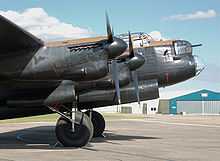Nose gunner

The nose gunner position on the Battle of Britain Memorial Flight Lancaster (PA474)
A nose gunner or front gunner is a crewman on a military aircraft who operates a machine gun turret in the front, or "nose", of the airplane. This position was usually manned by someone who only operated the gun, however, the nose gunner could have a dual role (navigation, bombardier, etc.). Also, stationary guns could be mounted in the nose and controlled by the pilot or co-pilot. Manned nose guns were most common during World War II, employed by both Allied and Axis forces.
Examples
Interwar
- Boulton Paul Overstrand - 1933 - RAF's first aircraft with (powered) front turret
WWII examples
During World War II, many aircraft were equipped with guns for protection against other aircraft. One of those guns was often fitted in a nose turret of the aircraft.
- The British Armstrong Whitworth Whitley (produced 1936 onwards), a medium bomber-type, which had a crew of five: the pilot, co-pilot, the wireless operator/navigator, the nose-gunner/bombardier and the tail gunner. The Whitley employed a single .303 in (7.7 mm) Vickers K machine gun in its nose.
- The Avro Lancaster nose turret was operated by the bombardier as necessary; the bombardiers position being directly below the turret.
- The American B-24 Liberator (introduced in 1939), which carried a lead crew made up of five officers (pilot, co-pilot, dead reckoning navigator, pilotage navigator/nose gunner and bombardier). It also had five enlisted men (engineer/top turret gunner, radio operator/waist gunner, a second waist gunner, ball turret gunner and tail turret gunner). It had a twin .50 in (12.7 mm) M2 Browning machine guns in the nose.
- The German Dornier Do 17 (introduced in 1937), a light bomber with a crew of four (pilot, bombardier/nose gunner, two gunners). It had a single 7.92 mm (0.312 in) MG 15.